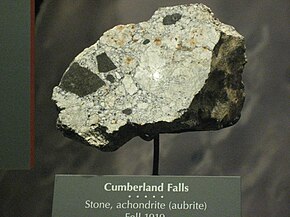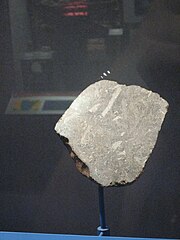
Summary
Aubrites are a group of meteorites named for Aubres,[1] a small achondrite meteorite that fell in 1836 in Aubres near Nyons, France. They are primarily composed of the orthopyroxene enstatite and are often called enstatite achondrites. Their igneous origin separates them from primitive enstatite achondrites and means they originated in an asteroid.
| Aubrite | |
|---|---|
| — Group — | |
 Cumberland Falls, an aubrite | |
| Type | Achondrite |
| Class | Asteroidal achondrite or enstatite achondrite |
| Parent body | Possibly (3103) Eger |
 Shallowater meteorite, an aubrite | |
Aubrites are typically light-colored with a brownish fusion crust. Most aubrites are heavily brecciated; they are often said to look "lunar" in origin.
Aubrites are primarily composed of large white crystals of the Fe-poor, Mg-rich orthopyroxene, or enstatite, with minor phases of olivine, nickel-iron metal, and troilite, indicating a magmatic formation under extremely reducing conditions. The severe brecciation of most aubrites attests to a violent history for their parent body. Since some aubrites contain chondritic xenoliths, it is likely that the aubrite parent body collided with an asteroid of "F-chondritic" composition.
Comparisons of aubrite spectra to the spectra of asteroids have revealed striking similarities between the aubrite group and the E-type asteroids of the Nysa family. A small near-Earth object, 3103 Eger, is also often suggested as the parent body of the aubrites.[2]
It has been suggested that aubrites may originate from the planet Mercury.[1][3]
See also edit
References edit
- ^ a b O'Callaghan, Jonathan (10 February 2024). "Fragments of Asteroid With Mystery Origin Are Found Outside Berlin - Astronomers tracked the entry of a small space rock into Earth's atmosphere, and then meteorite hunters made an unexpected discovery". The New York Times. Archived from the original on 10 February 2024. Retrieved 10 February 2024.
- ^ Gaffey, Michael J.; Reed, Kevin L.; Kelley, Michael S. (November 1992). "Relationship of E-type Apollo asteroid 3103 (1982 BB) to the enstatite achondrite meteorites and the Hungaria asteroids". Icarus. 100 (1): 95–109. doi:10.1016/0019-1035(92)90021-X. Retrieved 14 May 2021.
- ^ O'Callaghan, Jonathan (23 May 2022). "Shards of the Planet Mercury May Be Hiding on Earth". The New York Times. Retrieved 14 February 2023.
External links edit
- Encyclopedia − David Darling
- Academic Report 2004 (PDF)
- Academic Report 2006 (PDF)


